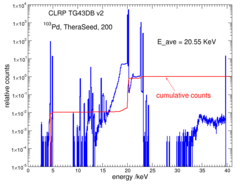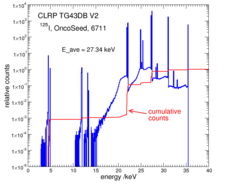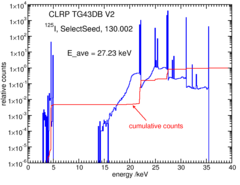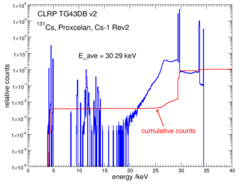
H. Safigholi, M. J. P. Chamberland, R. E. P. Taylor, C. H. Allen, M. P. Martinov, D. W. O. Rogers, and R. M. Thomson
As the high and low-energy databases were merged, mixed font sizes were introduced. This will be fixed. The data are not affected.
DISCLAIMER
The information contained in this CLRP TG-43 parameter database is provided for research and educational purposes only and must not be directly used for clinical applications, unless explicitly recommended for clinical use by the appropriate professional body (e.g., AAPM).
About the CLRPv2 Database
This is the home of version 2 (v2) of the Carleton Laboratory for Radiotherapy Physics (CLRP) Database of TG-43 brachytherapy dosimetry parameters 1-4. The dosimetry parameters presented here were calculated using the EGSnrc application egs_brachy, a Monte Carlo code for doing rapid brachytherapy dose calculations 5.
On these pages you will find a set of TG-43 dosimetry parameters for most of the brachytherapy sources listed in the Joint AAPM/RPC brachytherapy source registry. The aim of the present work is to create a comprehensive updated database of TG-43 dosimetry parameters using consistent methods for all sources. These data are made freely available to the public and we hope it will prove to be a valuable resource for the medical physics community.
CLRPv2 includes the TG-43 source information and mean photon energy for 40 low-energy LDR sources (17 103Pd, 22 125I, and 1 131Cs) and 33 high-energy sources (1 169Yb, 23 192Ir, 5 137Cs, and 4 60Co). The half-lives (τ1/2) of 103Pd, 125I, and 131Cs LDR sources reported by the BIPM are 16.964(10), 59.388(28) and 9.69(1) days, respectively 6. The half-lives of 103Pd, 125I, and 131Cs LDR sources reported by TG-43U1S2 7 are 16.991(34), 59.407 (10), and 9.689 (1) days, respectively. The half-lives of the high-energy sources reported by the NNDC are 30.08(9) years, 32.018(5) days and 1925.28(14) days for 137Cs, 169Yb and 60Co sources respectively.
Initial photon energies and probabilities are sampled from the NNDC spectra 8 for 103Pd and 131Cs sources. For 125I, the photon spectrum from NCRP Report 58 9 is used since it has been demonstrated that using the NCRP spectrum leads to better agreement with measured spectra for many seeds 10 and is consistent with the spectrum recommended by the BIPM for use by primary standards labs 6. Average photon energy of the initial bare spectra used here are 18.89, 28.39 and 27.61 keV for 103Pd, 125I, and 131Cs radionuclides, respectively. These average energies include lines below 5 keV. Without those lines the average energies are 20.72, 28.39 and 30.38 keV respectively. The initial photon spectra for the high-energy sources are also based on NNDC spectra. The average initial energies from the bare sources are 608.75, 82.68 and 1252.80 keV for 137Cs, 169Yb and 60Co sources respectively. However, following standard practice and ignoring initial photons below 10 keV, these averages increase to 614.73, 93.66 and 1252.87 keV respectively.
Average photon energies are reported for each source. These are the average energies of photons escaping the surface of the source. Photon energy spectra calculated using egs_brachy surface count scoring option to get the spectrum on the surface of the source for three representative LDR sources are shown here. The relative counts are the counts per 0.1 keV bin per MeV normalized to 1 count total in the spectrum. Corresponding spectra are presented for all high-energy sources on their individual webpages.
For high-energy sources, air kerma per history is always calculated using a tracklength estimator for photons above the threshold δ (10 keV as recommended for high-energy brachy sources) in a 10x10x0.05 cm3 air voxel located in vacuo on the transverse axis 100 cm away from the source and then corrected (kr2 = 1.00217) for lateral and thickness dimensions of the scoring voxel to give the air-kerma per history on the central axis at a point 100 cm from the source,s midpoint as discussed in previous studies 4,11,12. Air-kerma strength per history factors, SKhist, are then calculated by multiplying the air kerma per history at 100 cm by d2 =104. The air-kerma strength per history factors for all CLRPv2 high-energy sources are here.
For high-energy sources, dose rate constants, Λ, are calculated by dividing the dose to water per history in a (0.1 mm)3 voxel centred on the reference position, (1 cm, Π/2), in the 80x80x80 cm3 water phantom, by the air-kerma strength per history factor, SKhist .
In-phantom dose calculations are generally done using tracklength scoring which ignores electron transport. However, as shown in our associated paper on high-energy sources 4, electron transport has little effect except very close to the source and except for the Co-60 sources. Co-60 dose calculations are done with electron transport. The effects on g(r) can be greater than 1% out to radii of 6 or 7 mm although effects on F(r,θ) are only significant for radii < 0.25 cm near 0 and 180 degrees. For other radionuclides, the effects are only significant closer to the source and not reported here. Examples of g(r) calculated with electron transport vs using tracklength scoring are provided on the pages of 4 representative high-energy sources, the Co-60 A86, the Cs-137 M11, the Yb-169, and the generic Ir-192. The calculations also ignore the dose due to the initial electrons directly from the radionuclides since it has been shown to be very small except very close to the source 4.
The egs_brachy source models and initial energy spectra used to create this database are available as part of the egs_brachy distribution at https://github.com/clrp-code/egs_brachy.
Users of this database may also find other useful information on the CLRP Links page.
Brachytherapy Source Data:
For the current list of sources covered by TG-43 and the Joint AAPM/RPC brachytherapy source registry please visit the RPC website.
Listings marked by an asterisk (*) indicate a source that was not on the previous version of the CLRP TG-43 Parameter Database.
Low energy sources
We ask that anyone using data found on these web pages to please cite our report on the appropriate part of the dataset as published in Medical Physics.
H. Safigholi, M. J. P. Chamberland, R. E. P. Taylor, C. H. Allen, M. P. Martinov, D. W. O. Rogers, and R. M. Thomson, Update of the CLRP TG-43 parameter database for low-energy brachytherapy sources, Med Phys., 47, 4556-4669 (2020)
H. Safigholi, M. J. P. Chamberland, R. E. P. Taylor, M. P. Martinov, D. W. O. Rogers, and R. M. Thomson, Update of the CLRP Monte Carlo TG-43 parameter database for high-energy brachytherapy sources, in press Med Phys, Dec 2022,
References:
1. R. E. P. Taylor, D. W. O. Rogers, An EGSnrc Monte Carlo-calculated database of TG-43 parameters, Med. Phys., 35, 4228-4241, 2008
2. R. E. P. Taylor, D. W. O. Rogers, More accurate fitting of 125I and 103Pd radial dose functions, Med. Phys., 35, 4242-4250, 2008
3. H. Safigholi, M. J. P. Chamberland, R. E. P. Taylor, C. H. Allen, M. P. Martinov, D. W. O. Rogers, and R. M. Thomson, Update of the CLRP TG-43 parameter database for low-energy brachytherapy sources, Med phys., 47, 4556-4669 (2020)
4. H. Safigholi, M. J. P. Chamberland, R. E. P. Taylor, C, M. P. Martinov, D. W. O. Rogers, and R. M. Thomson, Update of the CLRP TG-43 Parameter Database for High-Energy Brachytherapy Sources, accepted to Med.Phys., Dec 2022 (Current work).
5. M Chamberland, RE Taylor, DWO Rogers, RM Thomson, egs_brachy: a versatile and fast Monte Carlo code for brachytherapy, Phys. Med. Biol., 23, 8214-8231, 2016
11. R. E. P. Taylor, G. Yegin, and D. W. O. Rogers, Benchmarking BrachyDose: voxel-based EGSnrc Monte Carlo calculations of TG-43 dosimetry parameters, Med. Phys. 34, 445-570, 2007.
12. D. W. O. Rogers, Inverse square corrections for FACs and WAFACs, Appl. Radiat. Isot. 153, 108638(8pp) (2019)
Contact Information:
David Rogers E-mail: drogers
 physics [dot] carleton [dot] ca
physics [dot] carleton [dot] caImportant Note
The previous version of the CLRP TG-43 database (CLRP-TG43v1) is available here for archival purposes.



